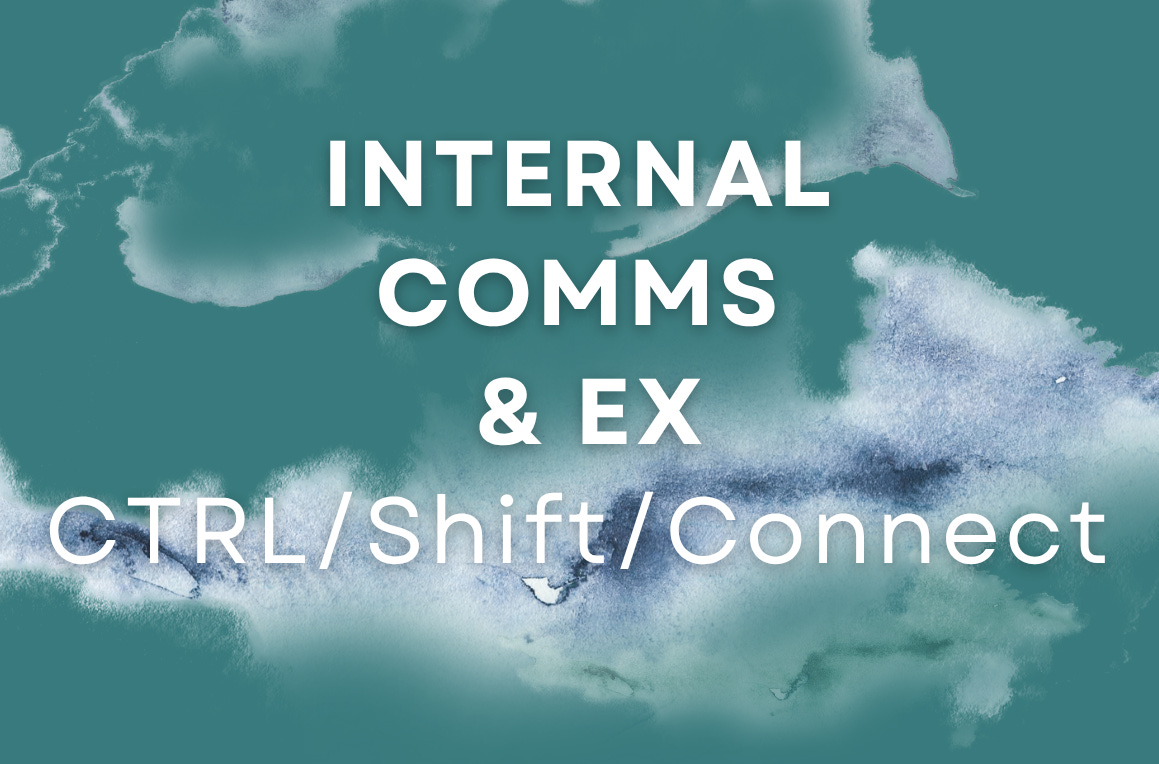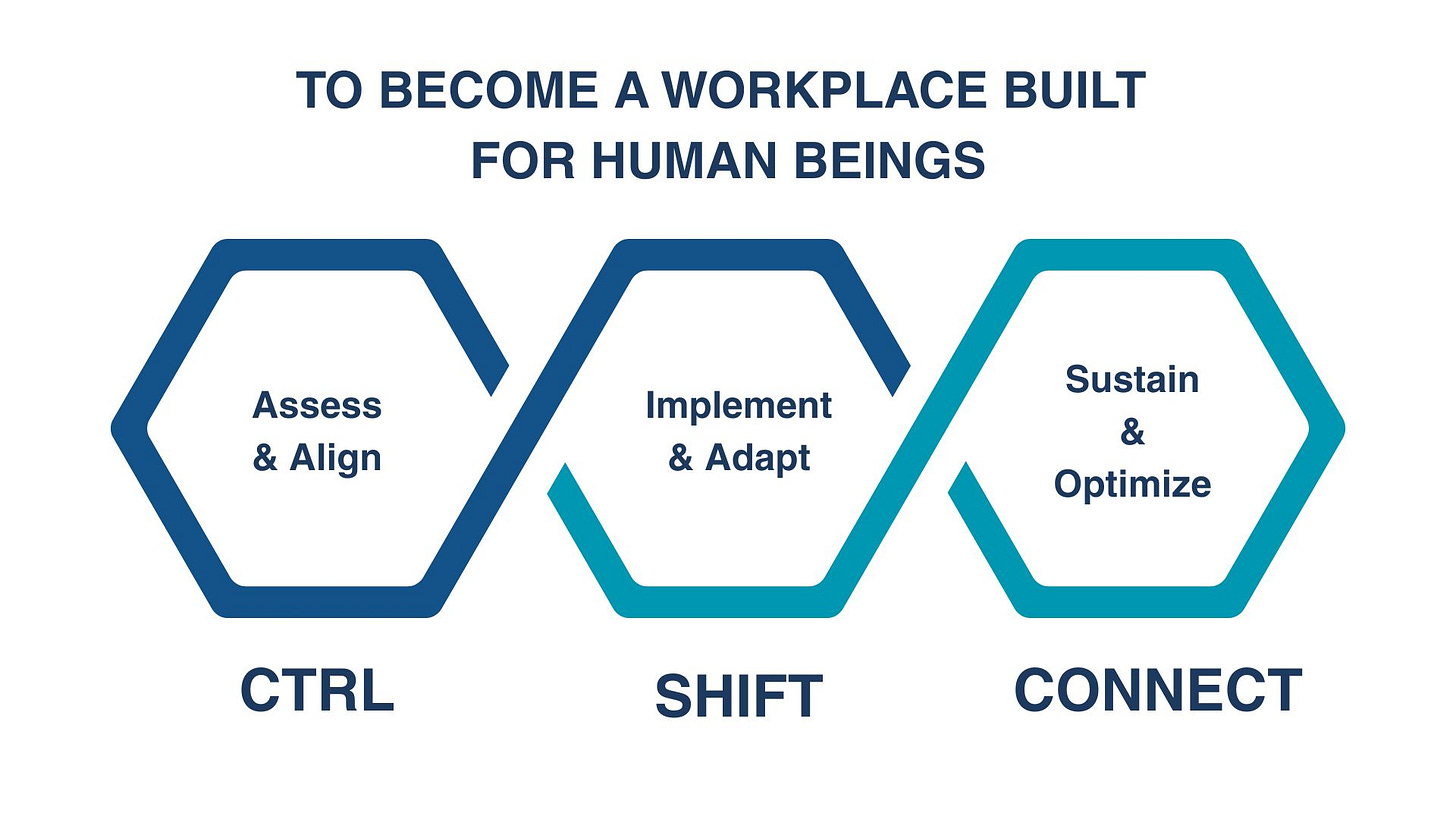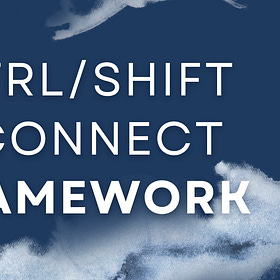Internal Comms: CTRL/Shift/Connect
How to co-lead a shift to a workplace that's better for human beings
The cross-functional framework
Ctrl/Shift/Connect is a strategy for aligning people, systems, and leadership behavior to create a thriving, sustainable cultural operating system. Think of it as a system update rather than a full reboot that you can drive, in close partnership with your Leadership, HR, Operations, IT, and Finance. CTRL/Shift/Connect helps organizations implement meaningful, scalable change that supports both employee thriving and long-term business success. More about the framework and an explanation for C-suite execs.
Internal Comms/EX - Ctrl: Assess & Align
Take stock of what’s going on and map out the journey forward:
Review previous engagement surveys and conduct an employee needs assessment. You can use Alderfer’s ERG model (a workplace-adapted version of Maslow’s hierarchy of needs). Other models for assessment could be the Gallup 10-part job quality index or McKinsey & Company’s 12 factors that affect employees’ satisfaction and commitment levels.
Do a comms inventory to assess which systems, strategies, and tactics need updating on a tactical level. Identify existing data, spot gaps, and identify where to scale up or pare down.
Evaluate existing Employee Value Proposition (EVP) against leadership communications, manager practices, policies, behavioral norms, and employee communities (e.g., employee resource groups and culture initiatives) to identify areas for improvement.
If no EVP is in place, partner with Leadership/CEO, HR (L&D, Compensation, HR Business Partners, Onboarding), Finance, IT, and employee representatives to get clarity on the changes that will enhance the employee experience and align with the CEOs vision for culture.
If there’s openness to creating a new EVP, this can be done in close collaboration with the CEO and leadership team. There should also be room to discuss streamlining other internal models(values/behaviors, goals, pillars) if it will clarify culture.
Set goals and decide on metrics for employee engagement and thriving, recognizing that engagement is the gateway to performance and thriving employees are the engine of a thriving business. You may also want to track productivity, turnover, and absenteeism.
These changes may include more transparent leadership communication, improved technology (like intranet updates), or structured feedback loops to alleviate operational pain points. The goal is to ensure that employee needs are integrated into organizational decisions, benefiting both employees and the business in the long run.
Internal Comms/EX - Shift: Implement & Adapt
Once the plan is in place, begin execution while keeping flexibility in mind:
Communicate clearly to employees and stakeholders before, during, and after any changes.
Gather feedback and input along the way. Use pilot groups to test initiatives and adjust as needed, always keeping the employee perspective top of mind.
Internal Comms/EX - Connect: Sustain & Optimize
Ensure that improvements stick and continue evolving:
Regularly assess and refine strategies through engagement surveys, retention data, and productivity trends.
Strengthen alignment across Leadership, HR, Operations, IT, and Finance to maintain a human-first workplace.
Foster continuous growth by embedding employee well-being and engagement into the organization’s long-term success strategy.
A favorite case study: NUMMI in the 1980s
When Toyota and GM partnered to adopt a people-first approach with a GM plant’s notoriously “worst workforce,” they had incredible success. The joint venture embraced Toyota’s version of management (a style that meets employees’ needs) and turned a dysfunctional workforce into an engaged and productive one. Absenteeism dropped from over 20% to under 4%. Total labor hours per unit went from 43 hours down to 21 hours. And quality improved dramatically. All with 85% of the exact same workforce (Zeynep Ton, p. 50, The Case for Good Jobs). Kind of amazing.
Now, they didn’t use the Ctrl/Shift/Connect framework or RPIE to roll out the changes—they had their own process at the time—but it actually maps (quite elegantly) onto Ctrl/Shift/Connect. And I don’t think they used Maslow’s hierarchy of needs or the ERG theory to assess employee needs, but these are such classic concepts that I think we can use that lens here.
Ctrl: Assess & Align at NUMMI
The foundation of this transformation was a deep assessment of existing dysfunction, followed by cross-functional alignment. Instead of replacing the workforce, Toyota retained the original employees and focused on changing the system. Employees were flown to Japan for training, and the company committed to creating a secure, stable workplace that met workers’ Existence needs through fair pay, job security, and improved working conditions. This alignment between leadership, union leaders, and plant managers laid the groundwork for a successful shift in norms and expectations.
Shift: Implement & Adapt at NUMMI
Toyota introduced a radically different communication model rooted in collaboration, feedback, and respect. They implemented team-based work structures and gave employees the autonomy to stop the production line if quality was at risk. Leaders acted as coaches, and structured team processes encouraged open dialogue and constant improvement. Workers learned new skills and were empowered to suggest process changes. These practices fulfilled their Relatedness needs through peer support and respect, as well as their Growth needs through real-time learning and accountability.
Connect: Sustain & Optimize at NUMMI
The culture of continuous improvement (kaizen) helped institutionalize these changes. Employees were contributing. Feedback loops, recognition systems, and communication rituals helped maintain alignment across the organization. Employees reported renewed pride and purpose. As one worker told This American Life, “It changed my life from being depressed and bored… It changed me for the better.”
And the results went beyond employee transformation to operational success: fewer defects, faster output, and increased employee pride in the product.
Even though the plant is no longer operational, the NUMMI story continues to ripple outward. It offers a clear example of how aligned leadership, consistent communication, and cross-functional work can turn a struggling organization into a thriving one—all by meeting human needs through intentional system design.
If you want to know more about NUMMI, check out this great This American Life episode: https://www.thisamericanlife.org/561/nummi
More on the framework and how the Ctrl/Shift/Connect stages align with common models like Agile, ADKAR, and RPIE, so you know exactly how to work with your CEO and leaders as the project sponsors:
The CTRL/Shift/Connect Framework
In an era defined by disruption, trust erosion, and AI-fueled acceleration, leadership can no longer rely on old playbooks. Ctrl/Shift/Connect is a flexible framework to help CEOs lead cultural transformation with clarity, without micromanaging execution.
Why Human Beings / Human Doings?
I use terms like “workplace for human beings,” “human being-orientation,” and “human doing vs. human being” interchangeably to describe human-centered, people-first workplaces (as opposed to transactional ones that often contribute to burnout and disconnection.)
Organizations with human-centered cultures and internal communications are more productive and resilient. Why it matters.
All content is available without a paid subscription, so please pass it along to anyone you think might benefit.
Chime in! The voluntary paid subscription gives you the ability to comment for the lowest possible monthly fee. This pay-to-comment model helps protect the space from bots, trolls, and drive-by cynicism. Please be thoughtful and respectful if you choose to engage. 💛



